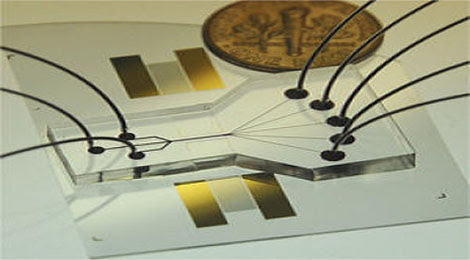Researchers at the University of California, Santa Barbara, have
become the first to combine a quantum processor with memory that can be
used to store instructions and data. This achievement in quantum
computing replicates a similar milestone in conventional computer design
from the 1940s.
Super cool: When chilled almost to absolute zero, this chip
becomes a quantum computer that includes both a processor (the two black
squares) and memory (the snaking lines on either side).
Although quantum computing is now mostly a research subject, it
holds out the promise of computers far more capable than those we use
today. The power of quantum computers comes from their version of the
most basic unit of computing, the bit. In a conventional computer, a bit
can represent either 1 or 0 at any time. Thanks to
the quirks of quantum mechanics, the equivalent in a quantum computer, a
qubit, can represent both values at once. When qubits in such a
"superposition" state work together, they can operate on exponentially
more data than the same number of regular bits. As a result, quantum
computers should be able to defeat encryption that is unbreakable in
practice today and perform highly complex simulations.
Linking a processor and memory elements brings such applications
closer, because it should make it more practical to control and program a
quantum computer can perform, says Matteo Mariantoni, who led the
project, which is part of a wider program at UCSB headed by John
Martinis and Andrew Cleland.
The design the researchers adopted is known as the von Neumann
architecture—named after John von Neumann, who pioneered the idea of
making computers that combine processor and memory. Before the first von
Neumann designs were built in the late 1940s, computers could be
reprogrammed only by physically reconfiguring them. "Every single
computer we use in our everyday lives is based on the von Neumann
architecture, and we have created the quantum mechanical equivalent,"
says Mariantoni.
The only quantum computing system available to buy—priced at $10 million—lacks memory and works like a pre-von Neumann computer.
Qubits can be made in a variety of ways, such as suspending ions or
atoms in magnetic fields. The UCSB group used more conventional
electrical circuits, albeit ones that must be cooled almost to absolute
zero to make them superconducting and activate their quantum behavior.
They can be fabricated by chip-making techniques used for conventional
computers. Mariantoni says that using superconducting circuits allowed
the team to place the qubits and memory elements close together on a
single chip, which made possible the new von Neumann-inspired design.
The processor consists of two qubits linked by a quantum bus that
enables them to communicate. Each is also connected to a memory element
into which the qubit can save its current value for later use, serving
the function of the RAM - for random access memory - of a conventional
computer. The links between the qubits and the memory contain devices
known as resonators, zigzagging circuits inside which a qubit's value
can live on for a short time.
Mariantoni's group has used the new system to run an algorithm that
is a kind of computational building block, called a Toffoli gate, which
can be used to implement any conventional computer program. The team
also used its design to perform a mathematical operation that underlies
to the algorithm with which a quantum computer might crack complex data
encryption.
David Schuster
leads a group at the University of Chicago that also works on quantum
computing, including superconducting circuits. He says that
superconducting circuits have recently proved to be comparatively
reliable. "One of the next big frontiers for these techniques now is
scale," he says. By replicating the Von Neumann architecture the UCSB
team have expanded that frontier.
That's not to say that quantum computers must all adopt that design,
though, as conventional computers have. "You could make a computer
completely out of qubits and it could do every kind of calculation,"
says Schuster. However there are advantages to making use of resonators
like those that make up the new design's memory, he says. "Resonators
are easier and more reliable to make than qubits and easier to control,"
says Schuster.
Mariantoni agrees. "We can easily scale the number of these unit
cells," he says. "I believe that arrays of resonators will represent the
future of quantum computing with integrated circuits."
By Tom Simonite
From Technology Review














